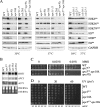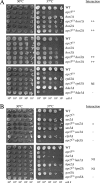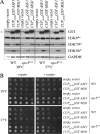The Saccharomyces cerevisiae anaphase-promoting complex interacts with multiple histone-modifying enzymes to regulate cell cycle progression
- PMID: 20709786
- PMCID: PMC2950418
- DOI: 10.1128/EC.00097-10
The Saccharomyces cerevisiae anaphase-promoting complex interacts with multiple histone-modifying enzymes to regulate cell cycle progression
Abstract
The anaphase-promoting complex (APC), a large evolutionarily conserved ubiquitin ligase complex, regulates cell cycle progression through mitosis and G(1). Here, we present data suggesting that APC-dependent cell cycle progression relies on a specific set of posttranslational histone-modifying enzymes. Multiple APC subunit mutants were impaired in total and modified histone H3 protein content. Acetylated H3K56 (H3K56(Ac)) levels were as reduced as those of total H3, indicating that loading histones with H3K56(Ac) is unaffected in APC mutants. However, under restrictive conditions, H3K9(Ac) and dimethylated H3K79 (H3K79(me2)) levels were more greatly reduced than those of total H3. In a screen for histone acetyltransferase (HAT) and histone deacetylase (HDAC) mutants that genetically interact with the apc5(CA) (chromatin assembly) mutant, we found that deletion of GCN5 or ELP3 severely hampered apc5(CA) temperature-sensitive (ts) growth. Further analyses showed that (i) the elp3Δ gcn5Δ double mutant ts defect was epistatic to that observed in apc5(CA) cells; (ii) gcn5Δ and elp3Δ mutants accumulate in mitosis; and (iii) turnover of the APC substrate Clb2 is not impaired in elp3Δ gcn5Δ cells. Increased expression of ELP3 and GCN5, as well as genes encoding the HAT Rtt109 and the chromatin assembly factors Msi1 and Asf1, suppressed apc5(CA) defects, while increased APC5 expression partially suppressed elp3Δ gcn5Δ growth defects. Finally, we demonstrate that Gcn5 is unstable during G(1) and following G(1) arrest and is stabilized in APC mutants. We present our working model in which Elp3/Gcn5 and the APC work together to facilitate passage through mitosis and G(1). To progress into S, we propose that at least Gcn5 must then be targeted for degradation in an APC-dependent fashion.
Figures








Similar articles
-
Contribution of CAF-I to anaphase-promoting-complex-mediated mitotic chromatin assembly in Saccharomyces cerevisiae.Eukaryot Cell. 2005 Apr;4(4):673-84. doi: 10.1128/EC.4.4.673-684.2005. Eukaryot Cell. 2005. PMID: 15821127 Free PMC article.
-
The Apc5 subunit of the anaphase-promoting complex/cyclosome interacts with poly(A) binding protein and represses internal ribosome entry site-mediated translation.Mol Cell Biol. 2004 May;24(9):3577-87. doi: 10.1128/MCB.24.9.3577-3587.2004. Mol Cell Biol. 2004. PMID: 15082755 Free PMC article.
-
The ubiquitin-dependent targeting pathway in Saccharomyces cerevisiae plays a critical role in multiple chromatin assembly regulatory steps.Genetics. 2002 Oct;162(2):615-32. doi: 10.1093/genetics/162.2.615. Genetics. 2002. PMID: 12399376 Free PMC article.
-
Cross-talk between APC/C and CBP/p300.Cancer Biol Ther. 2006 Jul;5(7):760-2. doi: 10.4161/cbt.5.7.3103. Epub 2006 Jul 13. Cancer Biol Ther. 2006. PMID: 16861917 Review.
-
Regulation of APC/C activators in mitosis and meiosis.Annu Rev Cell Dev Biol. 2008;24:475-99. doi: 10.1146/annurev.cellbio.041408.115949. Annu Rev Cell Dev Biol. 2008. PMID: 18598214 Free PMC article. Review.
Cited by
-
Mechanistic insights into aging, cell-cycle progression, and stress response.Front Physiol. 2012 Jun 4;3:183. doi: 10.3389/fphys.2012.00183. eCollection 2012. Front Physiol. 2012. PMID: 22675309 Free PMC article.
-
Antagonistic Gcn5-Hda1 interactions revealed by mutations to the Anaphase Promoting Complex in yeast.Cell Div. 2011 Jun 8;6(1):13. doi: 10.1186/1747-1028-6-13. Cell Div. 2011. PMID: 21651791 Free PMC article.
-
Identification of Novel Loci Involved in Adalimumab Response in Crohn's Disease Patients Using Integration of Genome Profiling and Isoform-Level Immune-Cell Deconvoluted Transcriptome Profiling of Colon Tissue.Pharmaceutics. 2022 Sep 7;14(9):1893. doi: 10.3390/pharmaceutics14091893. Pharmaceutics. 2022. PMID: 36145641 Free PMC article.
-
Fkh1 and Fkh2 associate with Sir2 to control CLB2 transcription under normal and oxidative stress conditions.Front Physiol. 2013 Jul 12;4:173. doi: 10.3389/fphys.2013.00173. eCollection 2013. Front Physiol. 2013. PMID: 23874301 Free PMC article.
-
Bypassing the requirement for an essential MYST acetyltransferase.Genetics. 2014 Jul;197(3):851-63. doi: 10.1534/genetics.114.165894. Epub 2014 May 15. Genetics. 2014. PMID: 24831819 Free PMC article.
References
-
- Ausubel F. M., Brent R., Kingston R. E., Moore D. D., Seidman J. G., Smith J. A., Struhl K. 1995. Current protocols in molecular biology. Wiley, New York, NY
-
- Baker D. J., Jeganathan K. B., Cameron J. D., Thompson M., Juneja S., Kopecka A., Kumar R., Jenkins R. B., de Groen P. C., Roche P., van Deursen J. M. 2004. BubR1 insufficiency causes early onset of aging-associated phenotypes and infertility in mice. Nat. Genet. 36:744–749 - PubMed
-
- Bellanger S., Blachon S., Mechali F., Bonne-Andrea C., Thierry F. 2005. High-risk but not low-risk HPV E2 proteins bind to the APC activators Cdh1 and Cdc20 and cause genomic instability. Cell Cycle 4:1608–1615 - PubMed
-
- Binné U. K., Classon M. K., Dick F. A., Wei W., Rape M., Kaelin W. G., Jr., Näär A. M., Dyson N. J. 2007. Retinoblastoma protein and anaphase-promoting complex physically interact and functionally cooperate during cell-cycle exit. Nat. Cell Biol. 9:225–232 - PubMed
Publication types
MeSH terms
Substances
Grants and funding
LinkOut - more resources
Full Text Sources
Other Literature Sources
Molecular Biology Databases

